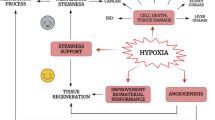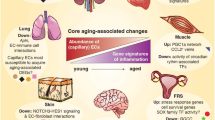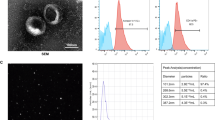Abstract
The distinct role of low-level laser irradiation (LLLI) on endothelial exosome biogenesis remains unclear. We hypothesize that laser irradiation of high dose in human endothelial cells (ECs) contributes to the modulation of exosome biogenesis via Wnt signaling pathway. When human ECs were treated with LLLI at a power density of 80 J/cm2, the survival rate reduced. The potential of irradiated cells to release exosomes was increased significantly by expressing genes CD63, Alix, Rab27a, and b. This occurrence coincided with an enhanced acetylcholine esterase activity, pseudopodia formation, and reduced zeta potential value 24 h post-irradiation. Western blotting showed the induction of LC3 and reduced level of P62, confirming autophagy response. Flow cytometry and electron microscopy analyses revealed the health status of the mitochondrial function indicated by normal ΔΨ activity without any changes in the transcription level of PINK1 and Optineurin. When cells exposed to high power laser irradiation, p-Akt/Akt ratio and in vitro tubulogenesis capacity were blunted. PCR array and bioinformatics analyses showed the induction of transcription factors promoting Wnt signaling pathways and GTPase activity. Thus, LLLI at high power intensity increased exosome biogenesis by the induction of autophagy and Wnt signaling. LLLI at high power intensity increases exosome biogenesis by engaging the transcription factors related to Wnt signaling and autophagy stimulate.






Similar content being viewed by others
Change history
28 November 2019
After publication of this paper, the authors determined an error in Fig.��4. Below is the correct Fig.��4.
References
Rezaie J, Mehranjani MS, Rahbarghazi R, Shariatzadeh MA Angiogenic and restorative abilities of human Mesenchymal stem cells were reduced following treatment with serum from diabetes mellitus type 2 patients. J Cell Biochem n/a-n/a. https://doi.org/10.1002/jcb.26211
Hassanpour M, Rezabakhsh A, Rahbarghazi R, Nourazarian A, Nouri M, Avci ÇB, Ghaderi S, Alidadyani N, Bagca BG, Bagheri HS (2017) Functional convergence of Akt protein with VEGFR-1 in human endothelial progenitor cells exposed to sera from patient with type 2 diabetes mellitus. Microvasc Res 114:101–113
Roskoski R (2017) Vascular endothelial growth factor (VEGF) and VEGF receptor inhibitors in the treatment of renal cell carcinomas. Pharmacol Res
Hoff PM, Machado KK (2012) Role of angiogenesis in the pathogenesis of cancer. Cancer Treat Rev 38(7):825–833
Ziyad S, Iruela-Arispe ML (2011) Molecular mechanisms of tumor angiogenesis. Genes Cancer 2(12):1085–1096. https://doi.org/10.1177/1947601911432334
Chen Q-H, Liu A-R, Qiu H-B, Yang Y (2015) Interaction between mesenchymal stem cells and endothelial cells restores endothelial permeability via paracrine hepatocyte growth factor in vitro. Stem Cell Res Ther 6(1):44
van Balkom BW, De Jong OG, Smits M, Brummelman J, den Ouden K, de Bree PM, van Eijndhoven MA, Pegtel DM, Stoorvogel W, Würdinger T (2013) Endothelial cells require miR-214 to secrete exosomes that suppress senescence and induce angiogenesis in human and mouse endothelial cells. Blood 121(19):3997–4006
Mulcahy LA, Pink RC, Carter DRF (2014) Routes and mechanisms of extracellular vesicle uptake. J Extracell Vesicles 3. https://doi.org/10.3402/jev.v3.24641
Ribeiro MF, Zhu H, Millard RW, Fan G-C (2013) Exosomes function in pro-and anti-angiogenesis. Curr Angiogenesis 2(1):54
Rezaie J, Ajezi S, Avci ÇB, Karimipour M, Geranmayeh MH, Nourazarian A, Sokullu E, Rezabakhsh A, Rahbarghazi R (2017) Exosomes and their application in biomedical field: difficulties and advantages. Mol Neurobiol. https://doi.org/10.1007/s12035-017-0582-7
Sarko DK, McKinney CE (2017) Exosomes: origins and therapeutic potential for neurodegenerative disease. Front Neurosci 11
Keller S, Ridinger J, Rupp A-K, Janssen JWG, Altevogt P (2011) Body fluid derived exosomes as a novel template for clinical diagnostics. J Transl Med 9:86–86. https://doi.org/10.1186/1479-5876-9-86
Alenquer M, Amorim MJ (2015) Exosome biogenesis, regulation, and function in viral infection. Viruses 7(9):5066–5083. https://doi.org/10.3390/v7092862
Ottaviani G, Martinelli V, Rupel K, Caronni N, Naseem A, Zandonà L, Perinetti G, Gobbo M, Di Lenarda R, Bussani R (2016) Laser therapy inhibits tumor growth in mice by promoting immune surveillance and vessel normalization. EBioMedicine 11:165–172
Akbarzadeh M, Nouri M, Banekohal MV, Cheraghi O, Tajalli H, Movassaghpour A, Soltani S, Cheraghi H, Feizy N, Montazersaheb S (2016) Effects of combination of melatonin and laser irradiation on ovarian cancer cells and endothelial lineage viability. Lasers Med Sci 31(8):1565–1572
Dias FJ, Issa JPM, Barbosa APA, de Vasconcelos PB, Watanabe I-S, MizusakiIyomasa M (2012) Effects of low-level laser irradiation in ultrastructural morphology, and immunoexpression of VEGF and VEGFR-2 of rat masseter muscle. Micron 43(2):237–244
Karu TI (2008) Mitochondrial signaling in mammalian cells activated by red and near-IR radiation. Photochem Photobiol 84(5):1091–1099
Huang L, Wu S, Xing D (2011) High fluence low-power laser irradiation induces apoptosis via inactivation of Akt/GSK3β signaling pathway. J Cell Physiol 226(3):588–601
Rezabakhsh A, Cheraghi O, Nourazarian A, Hassanpour M, Kazemi M, Ghaderi S, Faraji E, Rahbarghazi R, Avci ÇB, Bagca BG, Garjani A (2017) Type 2 diabetes inhibited human Mesenchymal stem cells Angiogenic response by over-activity of the Autophagic pathway. J Cell Biochem 118(6):1518–1530. https://doi.org/10.1002/jcb.25814
Kook S, Zhan X, Cleghorn W, Benovic J, Gurevich V, Gurevich E (2014) Caspase-cleaved arrestin-2 and BID cooperatively facilitate cytochrome C release and cell death. Cell Death Differ 21(1):172
Yi M, Parthiban P, Hwang J, Zhang X, Jeong H, Park DH, Kim D-K (2014) Effect of a bispidinone analog on mitochondria-mediated apoptosis in HeLa cells. Int J Oncol 44(1):327–335
Góralczyk K, Szymańska J, Łukowicz M, Drela E, Kotzbach R, Dubiel M, Michalska M, Góralczyk B, Zając A, Rość D (2015) Effect of LLLT on endothelial cells culture. Lasers Med Sci 30(1):273–278. https://doi.org/10.1007/s10103-014-1650-0
Bobrie A, Colombo M, Krumeich S, Raposo G, Théry C (2012) Diverse subpopulations of vesicles secreted by different intracellular mechanisms are present in exosome preparations obtained by differential ultracentrifugation. J Extracell Vesicles 1. https://doi.org/10.3402/jev.v1i0.18397
Jelonek K, Widlak P, Pietrowska M (2016) The influence of ionizing radiation on Exosome composition, secretion and intercellular communication. Protein Pept Lett 23(7):656–663. https://doi.org/10.2174/0929866523666160427105138
Al Musawi MS, Jaafar MS, Al-Gailani B, Ahmed NM, Suhaimi FM (2017) Laser-induced changes of in vitro erythrocyte sedimentation rate. Lasers Med Sci. https://doi.org/10.1007/s10103-017-2340-5
Fernandes HP, Cesar CL, Barjas-Castro ML (2011) Electrical properties of the red blood cell membrane and immunohematological investigation. Rev Bras Hematol Hemoter 33(4):297–301. https://doi.org/10.5581/1516-8484.20110080
Chang Z, Shi G, Jin J, Guo H, Guo X, Luo F, Song Y, Jia X (2013) Dual PI3K/mTOR inhibitor NVP-BEZ235-induced apoptosis of hepatocellular carcinoma cell lines is enhanced by inhibitors of autophagy. Int J Mol Med 31(6):1449–1456
Chen Y-D, Fang Y-T, Cheng Y-L, Lin C-F, Hsu L-J, Wang S-Y, Anderson R, Chang C-P, Lin Y-S (2017) Exophagy of annexin A2 via RAB11, RAB8A and RAB27A in IFN-γ-stimulated lung epithelial cells. Sci Rep 7
Rohringer S, Holnthoner W, Chaudary S, Slezak P, Priglinger E, Strassl M, Pill K, Mühleder S, Redl H, Dungel P (2017) The impact of wavelengths of LED light-therapy on endothelial cells. Sci Rep 7
Ricci R, Pazos M, Borges RE, Pacheco-Soares C (2009) Biomodulation with low-level laser radiation induces changes in endothelial cell actin filaments and cytoskeletal organization. J Photochem Photobiol B Biol 95(1):6–8
Góralczyk K, Szymańska J, Linkowska K, Ruszkowska-Ciastek B, Gryko Ł, Zając A, Grzybowski T, Rość D (2014) Effect of low level laser irradiation on VEGF gene expression in cultured endothelial cells. Med Res J 2(2):61–65
Gross JC, Chaudhary V, Bartscherer K, Boutros M (2012) Active Wnt proteins are secreted on exosomes. Nat Cell Biol 14(10):1036–1045
Koles K, Budnik V (2012) Exosomes go with the Wnt. Cell Logist 2(3):169–173
Cerpa W, Godoy JA, Alfaro I, Farías GG, Metcalfe MJ, Fuentealba R, Bonansco C, Inestrosa NC (2008) Wnt-7a modulates the synaptic vesicle cycle and synaptic transmission in hippocampal neurons. J Biol Chem 283(9):5918–5927. https://doi.org/10.1074/jbc.M705943200
Derkus B, Emregul KC, Emregul E (2017) A new approach in stem cell research-Exosomes: their mechanism of action via cellular pathways. Cell Biol Int
Hyenne V, Labouesse M, Goetz JG (2016) The small GTPase Ral orchestrates MVB biogenesis and exosome secretion. Small GTPases:1–7
Ostrowski M, Carmo NB, Krumeich S, Fanget I, Raposo G, Savina A, Moita CF, Schauer K, Hume AN, Freitas RP (2010) Rab27a and Rab27b control different steps of the exosome secretion pathway. Nat Cell Biol 12(1):19
Acknowledgments
Authors are immensely grateful to the personnel of Stem Cell Research Center for guidance and help.
Funding source
This study was supported by a grant from Tabriz University of Medical Sciences, Tabriz, Iran.
Author information
Authors and Affiliations
Corresponding authors
Ethics declarations
Conflict of interest
The authors declare that they have no conflicts of interest.
Ethical approval
All phase of in vitro assays in the current experiment was approved by the Ethics Committee of Tabriz University of Medical Sciences.
Additional information
Hesam Saghaei Bagheri, Monireh Mousavi, and Alireza Nourazarian are considered equally as co-first authors.
Electronic supplementary material
Fig. S1
Clustergram analysis (a), heat map graph of genes (b) involved in the Wnt signaling pathway. (GIF 159 kb)
Rights and permissions
About this article
Cite this article
Bagheri, H.S., Mousavi, M., Rezabakhsh, A. et al. Low-level laser irradiation at a high power intensity increased human endothelial cell exosome secretion via Wnt signaling. Lasers Med Sci 33, 1131–1145 (2018). https://doi.org/10.1007/s10103-018-2495-8
Received:
Accepted:
Published:
Issue Date:
DOI: https://doi.org/10.1007/s10103-018-2495-8




